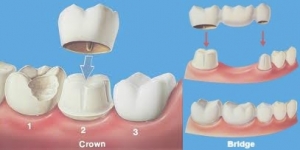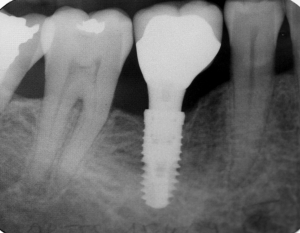Nothing can replace the natural teeth you were born with for chewing and function. However, very few people go through life without having teeth filled, crowns (caps) placed, or bridges and implants used to replace missing teeth. Crowns, bridges, and implants are the best answer and closest to your natural teeth, but they are not the same as healthy, natural teeth.
Crowns
Crowns are used to reconstruct a single tooth broken down by dental decay. Crowns are made of ceramic, resin, porcelain, porcelain plus metal, or resin plus metal materials. They are bonded or cemented onto the prepared tooth and cannot easily be removed from the tooth once placed. If the tooth was in good alignment before the crown was prepared, the crown will be in good alignment. If the tooth was misaligned before the crown, sometimes the crown may be made to obtain a more ideal shape and position. It is cleaned and flossed just like a natural tooth and is most like real teeth.
 http://vividdental.com.au/crowns-bridges-and-implants/
http://vividdental.com.au/crowns-bridges-and-implants/
Bridges
Bridges are crowns that are attached together, suspending the crown portion of a false tooth in or over the space left by the missing tooth. A bridge can be used to replace one or several teeth. Sometimes a bridge is used to splint loose teeth together in order to make the teeth more stable. Bridges are usually made of metal covered with either porcelain or resin. Some of the newer bridges are made of all resin or all ceramic materials. They are cemented or bonded onto the existing prepared teeth and are not easily removed once placed. The bridge teeth can be brushed the same as natural teeth, but since they are attached together, must be flossed differently by using a floss threader or other device.
The teeth are generally the same shape as natural teeth. However, if the existing teeth (abutments) that are used to anchor the bridge have moved from their original position because a tooth or teeth have been missing for years, the added tooth (pontic) may be longer or shorter than the tooth that it is replacing. With a bridge, the false tooth will most often butt up against the soft tissue ridge where the removed tooth was.
The shape of the tongue side of the false tooth varies. It is usually smaller on the tongue side and completely fills the space. Food will have more of a tendency to collect in this area, so you must be prepared to clean it. If the missing tooth has been gone a long time, the ridge may have shrunk considerably, and the pontic tooth will be longer than the teeth on either side. If this is the case, there are several periodontal procedures that can be done prior to the construction of the bridge. These procedures will build up the tissue to its former height. The more your mouth has changed from its normal state, the harder it is to make new teeth look and feel natural.
Implant Crowns
 Implant Crowns are used to replace single or multiple missing teeth. They are either cemented or screw-retained onto an implant fixture. The crowns are made of porcelain or resin and metal. But they have some significant differences from the natural teeth they replace. Teeth are supported by a root or roots that are irregular in shape. Implants are round. The cross-sectional of the implant will never match that of the tooth it is replacing. A multirooted tooth may be replaced by a single implant, so the manner in which an implant crown comes out of the soft tissue ridge will appear different from a natural tooth. There will be more space between the implant root and the adjacent teeth. Implant crowns are often cemented with temporary cement. This allows the dentist to easily take off the crown and evaluate how the implant is doing. Crowns on teeth are usually cemented with a final cement. Implant-supported crowns are wonderful, but not the same as natural teeth with crowns. Be prepared for some differences. Expect more maintenance on your part and in the dental office with crowns, bridges, and implants.
Implant Crowns are used to replace single or multiple missing teeth. They are either cemented or screw-retained onto an implant fixture. The crowns are made of porcelain or resin and metal. But they have some significant differences from the natural teeth they replace. Teeth are supported by a root or roots that are irregular in shape. Implants are round. The cross-sectional of the implant will never match that of the tooth it is replacing. A multirooted tooth may be replaced by a single implant, so the manner in which an implant crown comes out of the soft tissue ridge will appear different from a natural tooth. There will be more space between the implant root and the adjacent teeth. Implant crowns are often cemented with temporary cement. This allows the dentist to easily take off the crown and evaluate how the implant is doing. Crowns on teeth are usually cemented with a final cement. Implant-supported crowns are wonderful, but not the same as natural teeth with crowns. Be prepared for some differences. Expect more maintenance on your part and in the dental office with crowns, bridges, and implants.
Smokers take note: There is a heightened risk of dental implant failure among smokers – as much as a 20% greater failure rate!
If you have any questions about implants, crowns, and bridges, please feel free to ask us!
Star of Texas Dental Assisting School
(512) 487-1547

